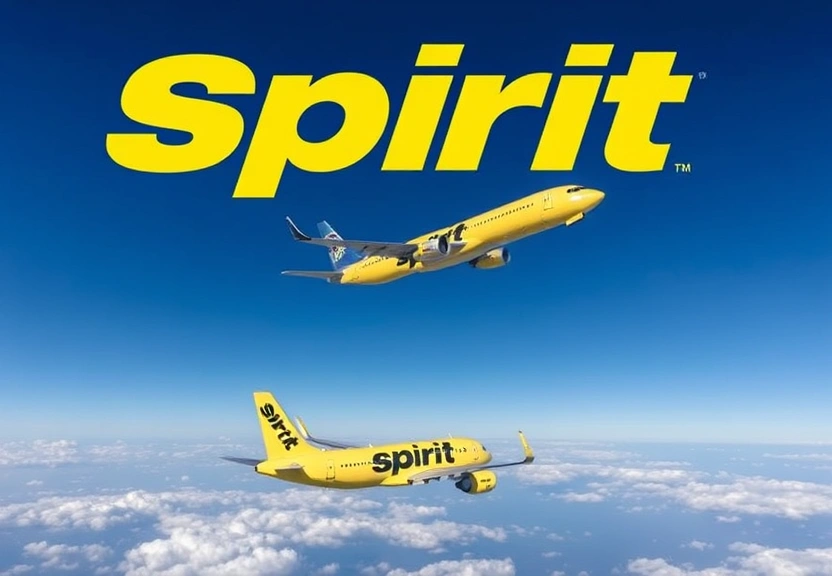Spirit Airlines Cuts Deep: 270 Pilots Furloughed and 140 Demoted Amid Schedule Reductions
In a significant move reflecting the ongoing turbulence in the airline industry, Spirit Airlines has announced the furlough of 270 pilots and the demotion of 140 others as part of a broader strategy to reduce operational costs in light of schedule reductions. This decision comes during a time when many airlines are grappling with the aftermath of the COVID-19 pandemic, fluctuating travel demand, and rising operational expenses. The ramifications of these employment changes extend beyond the immediate workforce, impacting the airline’s service offerings and overall market positioning.

As the airline industry continues to navigate recovery challenges, Spirit Airlines’ recent cuts serve as a stark reminder of the precarious nature of airline employment and operations. This article delves into the reasons behind these drastic measures, the potential impacts on pilots and the airline, and the broader implications for the airline industry as a whole.
The Current State of the Airline Industry
The airline industry has faced unprecedented challenges over the last few years, with the COVID-19 pandemic serving as a significant disruptor. As travel restrictions were imposed globally, airlines experienced a sharp decline in passenger numbers, leading to financial losses that many are still recovering from. The situation has since evolved, but the industry remains sensitive to economic fluctuations, fuel prices, and consumer confidence.
Post-Pandemic Recovery and Changes in Travel Demand
As travel demand began to rebound, airlines anticipated a swift recovery. However, factors such as rising inflation, increased costs, and geopolitical tensions have caused volatility in travel patterns. Airlines, including Spirit, have had to adapt by adjusting their flight schedules, cutting routes, and, in some instances, reducing the workforce.
Details of Spirit Airlines’ Employment Changes
Spirit Airlines recently announced the furlough of 270 pilots, which represents a significant portion of its pilot workforce. Additionally, the demotion of 140 pilots indicates a shift in the operational structure of the airline, with implications for those affected and the company’s overall strategy.
Reasons for Furloughs and Demotions
- Schedule Reductions: A direct response to decreased travel demand, Spirit has reduced its flight schedules, necessitating a smaller workforce.
- Cost Management: With rising operational costs, cutting labor expenses is a strategy many airlines are adopting to maintain profitability.
- Flexible Operations: The airline is likely aiming to create a more flexible operational model that can adapt quickly to changing market conditions.
Impact on Affected Pilots
The furloughs and demotions have immediate and long-term effects on the pilots involved. For those furloughed, the loss of income can be devastating, particularly for those who may not have alternative job prospects. Demoted pilots face reduced responsibilities and lower pay, which can impact their career trajectory. Additionally, the uncertainty surrounding future employment remains a significant concern for many in the aviation sector.
Broader Implications for the Airline Industry
Spirit Airlines’ cuts are indicative of wider trends in the airline industry. As airlines strive to balance financial stability with service delivery, workforce management becomes a critical focus. These changes not only affect the immediate employees but also have ripple effects on customer service and operational efficiency.
Industry-Wide Trends
Several trends have emerged in the airline industry as a result of the pandemic and its aftermath:
- Increased Automation: Airlines are investing in technology to streamline operations and reduce reliance on human resources.
- Talent Shortages: With many pilots leaving the industry during the pandemic, airlines face challenges in recruiting and retaining skilled personnel.
- Shift in Customer Expectations: Travelers are now more conscious of health and safety, leading to changes in service delivery and operational practices.
The Future of Spirit Airlines and Its Workforce
Looking ahead, Spirit Airlines faces a complex road to recovery. The decisions made today will shape its future operational capabilities and its relationships with employees. The airline’s management must navigate these turbulent waters carefully to ensure that they do not compromise service quality or employee morale.
Potential Recovery Strategies
To rebound from these challenges, Spirit Airlines might consider various strategies:
- Reassessing Flight Schedules: A thorough analysis of demand can help the airline optimize its routes and schedules to better align with passenger needs.
- Enhancing Employee Engagement: Maintaining open lines of communication with pilots and other staff can foster a sense of community and encourage loyalty.
- Investing in Technology: Streamlining operations through technology can help reduce costs and improve efficiency.
FAQs
1. Why did Spirit Airlines furlough pilots?
Spirit Airlines furloughed pilots as part of a strategy to manage operational costs in response to reduced flight schedules and decreased travel demand.
2. How many pilots were affected by the furloughs?
A total of 270 pilots were furloughed, along with 140 others who were demoted.
3. What are the implications for the airline industry?
The cuts reflect broader trends in the airline industry, including workforce management challenges, increased automation, and shifting customer expectations.
4. What can pilots do if they are furloughed?
Pilots who are furloughed may seek temporary employment in other sectors, pursue additional training, or wait for recall opportunities as the airline industry stabilizes.
5. How is Spirit Airlines planning to recover from these cuts?
Spirit Airlines may focus on reassessing flight schedules, enhancing employee engagement, and investing in technology to optimize operations and improve financial stability.
Conclusion
Spirit Airlines’ recent decision to furlough 270 pilots and demote 140 others is a significant development within the airline industry, underscoring the ongoing challenges faced by airlines in a post-pandemic world. As the industry continues to adapt to changing travel demand and economic realities, these employment changes highlight the delicate balance between operational efficiency and workforce morale. Moving forward, it will be essential for Spirit Airlines and its peers to navigate these challenges thoughtfully to ensure sustainable growth and a stable workforce.
📰 Original Source
Este artigo foi baseado em informações de: https://www.investing.com/news/stock-market-news/spirit-airlines-to-furlough-270-pilots-demote-140-more-on-downsized-schedule-4155870


